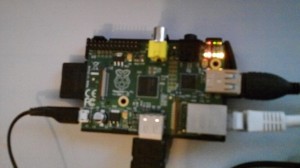[pdf] Installation de Raspberry Pi.[/pdf]
Installation de Raspberry Pi.[/pdf]
Distribution de travail : Debian/Ubuntu
Matériels :
- Carte Mémoire : Panasonic 16 Go Classe 10 à 20mo/s - Câble réseau RJ45 - Câble vidéo HDMI vers DVI - Ecran avec entrée DVI - Clavier USB - Souris USB - Hub USB - Câble d'alimentation Secteur vers Micro-USB, ici, câble d'alimentation pour téléphone portable Samsung - Connexion Internet - Ecouteurs
Informations :
– Utilisateur : pi
– Mot de passe : raspberry
« Raspberry Pi » commandé chez RS Component. Délai de livraison 3 semaines si indiqué : Despatch expected in 1 week(s)
I) Préparation de la carte mémoire.
1) Répertoire de travail :
[~] ➔ mkdir RASPBERRYPI [~] ➔ cd RASPBERRYPI/ [~/RASPBERRYPI] ➔
2) Télécharger RaspDebian Wheezy :
[~/RASPBERRYPI] ➔ wget http://anorien.csc.warwick.ac.uk/mirrors/raspberrypi.org/images/raspbian/2012-12-16-wheezy-raspbian/2012-12-16-wheezy-raspbian.zip [~/RASPBERRYPI] ➔ ls -l total 495704 -rw-r--r-- 1 lesanglier lesanglier 507098306 2012-12-16 22:00 2012-12-16-wheezy-raspbian.zip
Lien :
http://downloads.raspberrypi.org/download.php?file=/images/raspbian/2012-12-16-wheezy-raspbian/2012-12-16-wheezy-raspbian.zip
3) Décompresser l’archivage :
[~/RASPBERRYPI] ➔ unzip 2012-12-16-wheezy-raspbian.zip [~/RASPBERRYPI] ➔ ls -l *.img -rw-r--r-- 1 lesanglier lesanglier 1939865600 2012-12-16 20:52 2012-12-16-wheezy-raspbian.img
4) Insérer la carte sd :
5) Détecter la carte mémoire :
[~/RASPBERRYPI] ➔ sudo fdisk -l ... Disque /dev/sdd1: 16.0 Go, 16005464064 octets 255 têtes, 63 secteurs/piste, 1945 cylindres Unités = cylindres de 16065 * 512 = 8225280 octets Identifiant de disque : 0x00000000 Périphérique Amorce Début Fin Blocs Id Système /dev/sdd1 1 1946 15626240 c W95 FAT32 (LBA)
6) Copier l’image vers la carte mémoire :
Le nom du périphérique est : /dev/sdd
Sans le « 1 »
Sans barre de progression : [~/RASPBERRYPI] ➔ sudo dd bs=4M if=2012-12-16-wheezy-raspbian.img of=/dev/sdd 462+1 enregistrements lus 462+1 enregistrements écrits 1939865600 octets (1,9 GB) copiés, 350,754 s, 5,5 MB/s
Ou
Avec une barre de progression :
[~/RASPBERRYPI] ➔ sudo su root@station66:/home/lesanglier/RASPBERRYPI# dd if=2012-12-16-wheezy-raspbian.img | pv -s 1939865600 | dd of=/dev/sdd bs=4M 3788800+0 enregistrements lus==================================================================================================================================> ] 99% ETA 0:00:00 3788800+0 enregistrements écrits 1939865600 octets (1,9 GB) copiés, 1378,99 s, 1,4 MB/s 1,81GO 0:22:59 [1,34MO/s] [=====================================================================================================================================>] 100% 3788800+0 enregistrements lus 3788800+0 enregistrements écrits 1939865600 octets (1,9 GB) copiés, 1382,41 s, 1,4 MB/s
7) Enlever la carte mémoire du lecteur de carte mémoire SD
8) Lien :
http://lea-linux.org/documentations/Installation_de_la_carte_SD_du_Raspberry_Pi
http://www.benji1000.net/tutoriel-pour-debuter-avec-le-raspberry-pi/
II) Installation RaspBerry.
1) Connecter :
– Insérer la carte mémoire dans le Raspberry Pi
– Brancher le hub usb
– Brancher le câble vidéo, l’adaptateur et l’écran
– Brancher les périphérique d’entrée : clavier et souris
– Brancher la carte réseau vers le modem connecté à Internet
– Brancher les écouteurs
2) Brancher l’alimentation :
– DEL « PWR » : en rouge
– DEL « LDX » et « LNK » : en vert
– DEL « 100 » (Ethernert : en jaune

3) Configuration : Raspi-config
* Touches :
– Naviguation dans le menu : Flèches directionnel : monter ou descendre
– Changer d’options : Tabulation
– Cocher/décocher les cases d’option : Barre espace
* Configuration :
- expand_rootfs. - configure_keyboard - Keyboard model : Generic 105-key (intl) PC - Keyboard layout : Other - Country of origin for the keyboard : French - Keyboard layout : French - Key to function as AltGr : The default for the keyboard layout - Compose key : No compose key - Use Control+Alt+Backspace to terminate the X server? : No - change_local : - [] en_GB.UTF-8 UTF-8 : Décocher - [*] fr_FR ISO-8859-1 : Cocher - [*] fr_FR.UTF-8 UTF-8 : Cocher - Default locale for the system environement : fr_FR.UTF-8 - change_timezone : - Geographic area : Europe - Time zone : Paris - ssh : Enable - boot_behaviour : Yes - Finish : Yes
* Le système redémarre.
L’interface démarre automatiquement
III) Post-installation :
1) Installation de logiciels :
– Utilitaires :
pi@raspberrypi ~ $ sudo apt-get install mc vim screen
– Serveur LAMP :
pi@raspberrypi ~ $ sudo apt-get install apache2 php5 mysql-server phpmyadmin
– Graphisme :
pi@raspberrypi ~ $ sudo apt-get install gimp
– Bureautique :
pi@raspberrypi ~ $ sudo apt-get install abiword gnumeric
Lien :
http://domogy.fr/blog/133-raspberry-pi-utilisation-bureautique
2) Mettre une adresse ip statique :
Ouvrir :
/etc/network/interfaces
Chercher :
iface eth0 inet dhcp
Remplacer par :
#iface eth0 inet dhcp
Ajouter après :
iface eth0 inet static
address 192.168.1.108
netmask 255.255.255.0
network 192.168.1.0
broadcast 192.168.1.255
gateway 192.168.1.1
Action :
Redémarrer le Raspberry Pi
Lien :
http://www.tropfacile.net/doku.php/raspberry-pi/comment-mettre-une-ip-statique
IV) Audio :
1) Téléchargement d’une chanson de test :
pi@station08 ~ $ mkdir MUSIQUES pi@station08 ~ $ cd MUSIQUES/ pi@station08 ~/MUSIQUES $ wget http://couturierr.perso.neuf.fr/e-xtinction/Chaos%20And%20Decay.mp3
2) Vérification :
pi@station08 ~/MUSIQUES $ cat /proc/asound/cards
0 [ALSA ]: BRCM bcm2835 ALSbcm2835 ALSA - bcm2835 ALSA
bcm2835 ALSA
3) Installation de vlc :
pi@station08 ~/MUSIQUES $ sudo apt-get install vlc mpg123
4) Lecture du mp3 :
pi@station08 ~/MUSIQUES $ mpg123 Chaos\ And\ Decay.mp3
V) Remarques :
– S’il n’y a pas de connexion internet, la date et l’heure correspondent à la date et l’heure du dernier arrêt.
VI) Liens :
http://www.windtopik.fr/installation-et-configuration-de-raspbian-wheezy/
http://www.tropfacile.net/doku.php/raspberry-pi/comment-passer-votre-raspberry-en-francais